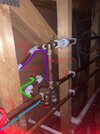- Joined
- 17 Feb 2019
- Messages
- 207
- Reaction score
- 13
- Country

Hi all,
Moved into a property earlier this year and noticed a really strong vibrating sound coming from the cylinder room on the top floor.
It happens for maybe 4-5 seconds in the morning when we're drawing hot water for the first time. Usually notice it when one of us has a shower in the morning but it can occur when we draw hot water for the first time in the day from any tap in the house too.
Literally as soon as the water starts feeling hot from the shower/taps that first time in the morning, you get this incredibly loud vibration in the cylinder room. It sort of dies down after that and won't do it really for the rest of the day. Never does it when drawing cold water either.... and probably worth mentioning in the past when we've been away for a few days and drawn hot water for the first time when back, it's an even an even stronger vibration then.
It's a tight space to try and show the setup of the boiler room. So i've done a couple videos too. Linked below separately.
Boiler Video 1
Boiler Video 2
Lastly i have had British gas out a couple times, I believe they replaced the white EV once or twice already...and said if the problem persisted they wouldn't know what else to do. Hence posting here, so really any guidance or things we can try would be massively appreciated as the noise is becoming a course for concern now.
thanks very much
G
Moved into a property earlier this year and noticed a really strong vibrating sound coming from the cylinder room on the top floor.
It happens for maybe 4-5 seconds in the morning when we're drawing hot water for the first time. Usually notice it when one of us has a shower in the morning but it can occur when we draw hot water for the first time in the day from any tap in the house too.
Literally as soon as the water starts feeling hot from the shower/taps that first time in the morning, you get this incredibly loud vibration in the cylinder room. It sort of dies down after that and won't do it really for the rest of the day. Never does it when drawing cold water either.... and probably worth mentioning in the past when we've been away for a few days and drawn hot water for the first time when back, it's an even an even stronger vibration then.
It's a tight space to try and show the setup of the boiler room. So i've done a couple videos too. Linked below separately.
Boiler Video 1
Boiler Video 2
Lastly i have had British gas out a couple times, I believe they replaced the white EV once or twice already...and said if the problem persisted they wouldn't know what else to do. Hence posting here, so really any guidance or things we can try would be massively appreciated as the noise is becoming a course for concern now.
thanks very much
G

